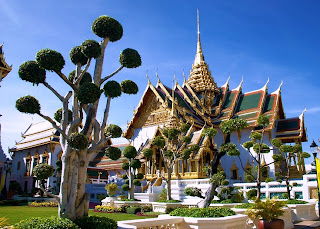Walking the grounds of the Grand Palace in Bangkok is like stepping back into the ancient period. The images of strange and beautiful mythical creatures and demons are visible in every corner. The smell of the burning incense is overwhelming, the air sparkles and shimmers with heat. Everything seems to be encrusted with jewels and mosaic inlay. Several objects which are considered as treasures of indescribable nature are housed in the Grand Palace, including the legendary Emerald Buddha. Millions of worshippers and visitors from far-away lands travel to Thailand to see this fabled palace, for most, to make the pilgrimage, pay their respects and say their prayers, and for some, to admire its beauty and learn its history.
The Grand Palace is a complex of buildings at the heart of Bangkok. It has been the official residence of the Kings of Siam (and later Thailand) since 1782. The king, his court and his royal government were based on the grounds of the palace until 1925. The present monarch, King Bhumibol Adulyadej (Rama IX), currently resides at Chitralada Palace, but Grand Palace is still used for official events. Several royal ceremonies and state functions are held within the walls of the palace every year.
Construction of the palace began on 6 May 1782, at the order of King Buddha Yodfa Chulaloke (Rama I), the founder of the Chakri Dynasty, when he moved the capital city from Thonburi to Bangkok. In shape, the palace complex is roughly rectangular and has a combined area of 218,400 square metres (2,351,000 sq ft), surrounded by four walls. It is situated on the banks of the Chao Phraya River at the heart of the Rattanakosin Island, today in the Phra Nakhon District.
Rather than being a single structure, the Grand Palace is made up of numerous buildings, halls, pavilions set around open lawns, gardens and courtyards. It is divided into several quarters: the Temple of the Emerald Buddha; the Outer Court, with many public buildings; the Middle Court, including the Phra Maha Montien Buildings, the Phra Maha Prasat Buildings and the Chakri Maha Prasat Buildings; the Inner Court and the Siwalai Gardens quarter.
Nowadays, the Grand Palace is currently partially open to the public as a museum that’s why it attracts millions of tourists every year who are willing to spend for air fare to Thailand just to see this magnificent palace. However it remains a working palace as several royal offices are still situated inside.
The layout of the Grand Palace followed that of the Royal Palace at Ayutthaya in location, organization, and in the divisions of separate courts, walls, gates and forts. Both palaces featured a proximity to the river. The location of a pavilion serving as a landing stage for barge processions also corresponded with that of the old palace. To the north of the Grand Palace there is a large field, the Thung Phra Men (now called Sanam Luang), which is used as an open space for royal ceremonies and as a parade ground. There was also a similar field in Ayutthaya, which was used for the same purpose. The road running north leads to the Front Palace, the residence of the Second King of Siam.
It is divided into four main courts, separated by numerous walls and gates: the Outer Court, the Middle Court, the Inner Court and the Temple of the Emerald Buddha. Each of these court's functions and access are clearly defined by laws and traditions. The Outer Court is situated on the northwestern part of the Grand Palace; within are the royal offices and (formerly) state ministries. To the northeast is the Temple of the Emerald Buddha, the royal chapel and home of the Emerald Buddha. The Middle Court housed the most important state apartments and ceremonial throne halls of the king. The Inner Court, situated at the most southern end of the complex, was reserved only for females, as it housed the king's harem.
The highlight of visiting the palace is seeing the 75cm Emerald Buddha which sits on a high platform in a richly decorated bòt. It’s guarded by mythical giants called yaksha. The Buddha is always dressed in different robes for each season. It was discovered in 1434 A.D. when lightning struck a stupa in Changrai in Northern Thailand. A Buddha statue was found inside and was brought to an abbot’s residence. Shortly after, the stucco on the nose flaked off to reveal its green surface. Interestingly enough, the Emerald Buddha isn’t made of emerald. It’s thought to be jade. People flocked from all over the country to worship the beautiful statue.
Today the Grand Palace is still a centre of ceremony and of the monarchy, and serves as a museum and tourist attraction as well.

















